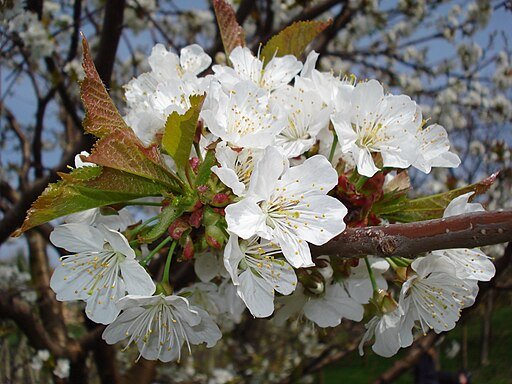In our first post we highlighted the historical role of the famous cherry trees in enacting plant inspections and the role of integrated pest management in keeping the cherry trees healthy. There is much more to the cherry trees than the pests they may have arrived with in 1912 and the insects that could threaten them in modern times. In this blog we explore the variety of trees that are included among the famous cherry trees and discuss some of the non-pest threats to their continued well-being.
Where are the cherries on these cherry trees?
Visitors to the cherry trees, especially young visitors, may be disappointed to learn that grocery store cherries do not come from these cherry trees. The trees that grow grocery store cherries are in the same genus as the famous trees along the National Mall. A genus is a scientific categorization that groups related species. Cherries are in the Prunus genus, which also includes other stone-fruit, like plums, apricots and even almonds!
Figure 1: A collage of cherry blossoms, some of which can be found in Washington DC. Cherry varieties can differ in flower color, size and shape. Credits (clockwise from top): Silverije, CC BY-SA 3.0, John Bauld from Toronto, Canada, CC BY 2.0 via Wikimedia Commons; Kelsey McGurrin
Astute visitors might also notice the variation in bloom color – from white to deep magenta. The cherry trees along the National Mall aren’t a single species, but are made up of 11 varieties of cherries, which encompasses both different species and different cultivars within species.
The cherry trees in Washington DC were famously a gift from the Japanese government – and the specific species and varieties are native to Japan. However, there are Prunus species that are native to the United States. The American plum (Prunus americana) and the chokecherry (Prunus virginiana) are two examples that can produce similarly beautiful blooms. However, before you plant Prunus species in your yard, be forewarned that both native and non-native Prunus species can be quite high maintenance – with lots of disease and pest concerns.
Cherry trees don’t swim
In the first blog we learned integrated pest management is used to keep the cherry trees pest free – but pests are just one of the threats that Washington DC’s cherry trees are facing. Soil compaction from so many visitors, climate change and rising sea levels are also pressing issues. The most famous of the DC cherry trees border the Tidal Basin where, as the name suggests, the tides from the Potomac River rise and fall twice a day. Tides are rising as part of global climate change, threatening the infrastructure of the Tidal Basin and the cherry trees that surround it. For the past several years the National Park Service has been forced to close parts of the sidewalk that encircle the Tidal Basin because they are partially or entirely submerged.
Figure 2: The Tidal Basin in DC floods regularly. Cherry trees are visible in the left background with their roots at or near the waterline. Credit: G. Edward Johnson, CC BY 4.0, via Wikimedia Commons
Cherry trees are not well-adapted to aquatic environments, so any flooding would weaken their health, but the situation is made worse because of the type of water that floods the Tidal Basin. The Potomac River is connected to the partially salty or “brackish” Chesapeake Bay. Thus, rising tides can also mean an influx of salty water, which weakens the cherry trees even more than fresh water might. Mitigating climate change and thus, stopping tides from rising further, would be the most complete solution to help the cherry trees – but that requires near global cooperation. Shorter term solutions are also being considered, including re-engineering the sea-wall that fortifies that Tidal Basin. The sea wall was built in 1882 and has not been substantially modified since!
Climate change and cherry blooms
Peak bloom, defined as the time when 70% of the flowers on the cherry trees are open, changes every year. This year, in 2022, the National Cherry Blossom Festival is scheduled from March 20 - April 17, but peak bloom has happened as early as March 15th in 1990 and as late as April 18th in 1958. (You can keep track of the progress on the bloom with the National Park Service’s Bloom Watch!).
Figure 3: Stages of blooming from a green bud to puffy blossoms. The timing of each stage is carefully tracked each year. Credit: NPS
With climate change, the time of peak bloom will be more variable and the bloom will become less synchronous. This could be a problem for the plants if they bloom during warm spells and winter weather returns. If there is a frost after the cherry buds are in the process of blooming, it can kill the buds, and the trees do not have the resources stored to put out buds for a second time in one year. This happened in 2017, killing half the buds before they could bloom. Changing temperatures can also be harmful for insects and other animals that rely on the trees.
Cherry trees in the next century
The cherry trees face many challenges, but they also have many advocates. Their health is monitored closely by many agencies and problems are treated as they arise. Design firms are re-imagining how the Tidal Basin and the low-lying National Mall can survive higher sea levels. Horticulturalists and breeders are working on creating varieties of Prunus trees that are more resistant to climate extremes, diseases and pests. Through these careful efforts, the cherry trees will hopefully be around for centuries to come.




